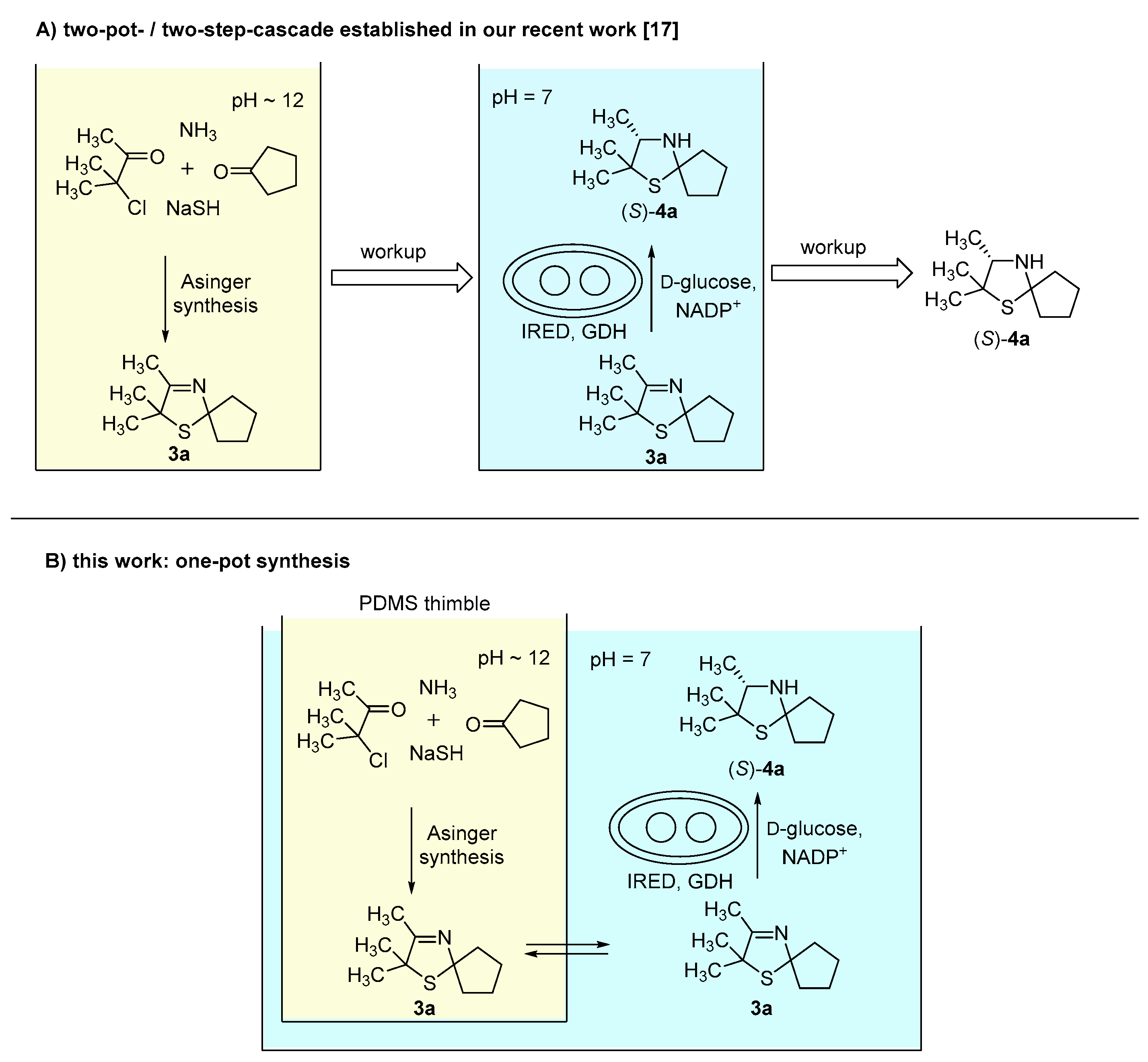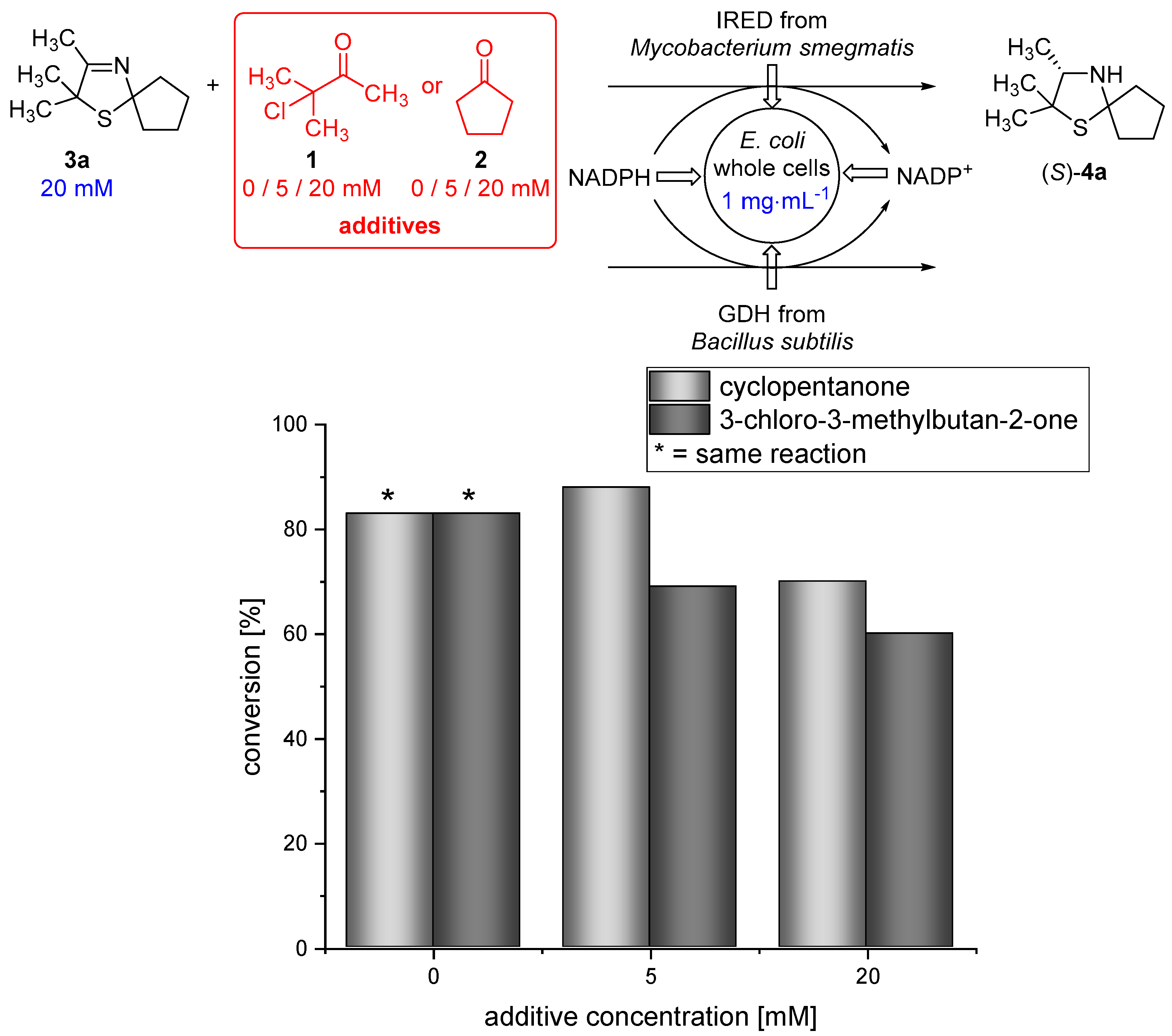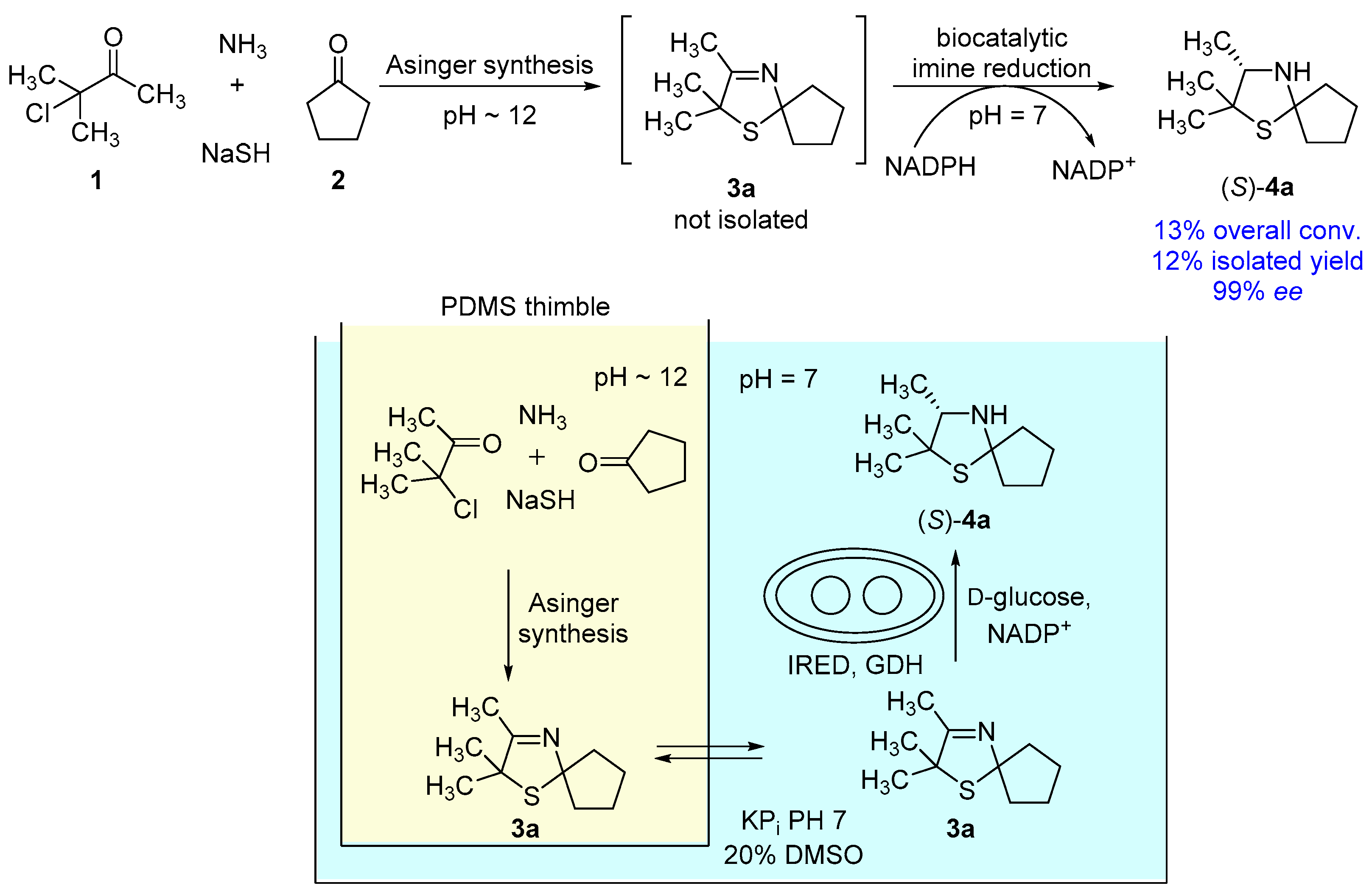Merging Heterocyclic Chemistry and Biocatalysis in One-Pot Processes through Compartmentalization of the Reaction Steps
Abstract
:1. Introduction
2. Materials and Methods
2.1. Preparation of the PDMS Thimbles for Compartmentalization of the Reaction Steps
2.2. Construction and Expression of Whole-Cell Catalyst
2.3. GC Analytics for the Determination of the Conversion
- Temperature program: 40 °C–200 °C, 10 °C·min−1.
- Retention time for 2,2,3-trimethyl-1-thia-4-azaspiro[4.4]non-3-ene (3a): 8.52 min.
- Retention time for 2,2,3-Trimethyl-1-thia-4-azaspiro[4.4]nonane (4a): 8.96 min.
2.4. Derivatization of 3-Thiazolidine (4a) with Phenylisocyanate

2.5. HPLC Analytics for the Determination of the Enantiomeric Excess
2.6. Biotransformation of 3-Thiazoline (3a) in the Presence of Different Amounts of Dimethyl Sulfoxide (DMSO)/3-Chloro-3-methylbutan-2-one (1)/Cyclopentanone (2)
2.7. Studies on Diffusion of 3a through the PDMS Membrane
2.8. Synthesis of 3-Thiazoline (3a) via Asinger-Reaction in Different Reactor Types
2.9. One-Pot Process Combining the Asinger-Synthesis of 3-Thiazoline (3a) with an Enzymatic Reduction via Compartmentalization of the Reaction Steps
3. Results and Discussion
3.1. Compartmentation Approach
3.2. Studies on Asinger-Type Multi-Component Reaction
3.3. Diffusion Efficiency and Biocatalytic Reduction Using Imine Reductases
3.4. One-Pot Process Combining the Asinger-Synthesis of 3-Thiazoline (3a) with an Enzymatic Reduction via Compartmentalization of the Reaction Steps
4. Conclusions
Author Contributions
Funding
Acknowledgments
Conflicts of Interest
References
- Rudroff, F.; Mihovilovic, M.D.; Gröger, H.; Snajdrova, R.; Iding, H.; Bornscheuer, U.T. Opportunities and challenges for combining chemo- and biocatalysis. Nat. Catal. 2018, 1, 12–22. [Google Scholar] [CrossRef] [Green Version]
- Gröger, H. Emerging Fields in One-Pot Multi-step Synthesis with Combined Chemo- and Bio-catalysts: Sequential- and Domino-Type Process Concepts as well as Compartmentation Strategies. In Modern Biocatalysis: Advances Towards Synthetic Biological Systems; Williams, G., Hall, M., Eds.; Royal Society of Chemistry: Cambridge, UK, 2018; pp. 439–472. [Google Scholar]
- Denard, C.A.; Huang, H.; Bartlett, M.J.; Lu, L.; Tan, Y.; Zhao, H.; Hartwig, J.F. Cooperative tandem catalysis by an organometallic complex and a metalloenzyme. Angew. Chem. Int. Ed. 2014, 53, 465–469. [Google Scholar] [CrossRef] [PubMed]
- Heidlindemann, M.; Rulli, G.; Berkessel, A.; Hummel, W.; Gröger, H. Combination of asymmetric organo- and biocatalytic reactions in organic media using immobilized catalysts in different compartments. ACS Catal. 2014, 4, 1099–1103. [Google Scholar] [CrossRef]
- Wang, Z.J.; Clary, K.N.; Bergman, R.G.; Raymond, K.N.; Toste, F.D. A supramolecular approach to combining enzymatic and transition metal catalysis. Nat. Chem. 2013, 5, 100–103. [Google Scholar] [CrossRef] [PubMed]
- Köhler, V.; Wilson, Y.M.; Dürrenberger, M.; Ghislieri, D.; Churakova, E.; Quinto, T.; Knörr, L.; Häussinger, D.; Hollmann, F.; Turner, N.J.; et al. Synthetic cascades are enabled by combining biocatalysts with artificial metalloenzymes. Nat. Chem. 2013, 5, 93–99. [Google Scholar] [CrossRef] [PubMed]
- Okamoto, Y.; Köhler, V.; Ward, T.R. An NAD(P)H-Dependent artificial transfer hydrogenase for multienzymatic cascades. J. Am. Chem. Soc. 2016, 138, 5781–5784. [Google Scholar] [CrossRef] [PubMed]
- Okamoto, Y.; Köhler, V.; Paul, C.E.; Hollmann, F.; Ward, T.R. Efficient in situ regeneration of NADH mimics by an artificial metalloenzyme. ACS Catal. 2016, 6, 3553–3557. [Google Scholar] [CrossRef]
- Brahma, A.; Musio, B.; Ismayilova, U.; Nikbin, N.; Kamptmann, S.; Siegert, P.; Jeromin, G.; Ley, S.; Pohl, M. An orthogonal biocatalytic approach for the safe generation and use of HCN in a multistep continuous preparation of chiral O-acetylcyanohydrins. Synlett 2016, 27, 262–266. [Google Scholar] [CrossRef] [Green Version]
- Miller, A.L.; Bowden, N.B. Site-isolation and recycling of PdCl(2) using PDMS thimbles. J. Org. Chem. 2009, 74, 4834–4840. [Google Scholar] [CrossRef] [PubMed]
- Mwangi, M.T.; Runge, M.B.; Hoak, K.M.; Schulz, M.D.; Bowden, N.B. A materials approach to site-isolation of Grubbs catalysts from incompatible solvents and m-chloroperoxybenzoic acid. Chem. Eur. J. 2008, 14, 6780–6788. [Google Scholar] [CrossRef] [PubMed]
- Runge, M.B.; Mwangi, M.T.; Miller, A.L.; Perring, M.; Bowden, N.B. Cascade reactions using LiAlH4 and grignard reagents in the presence of water. Angew. Chem. Int. Ed. 2008, 47, 935–939. [Google Scholar] [CrossRef] [PubMed]
- Sato, H.; Hummel, W.; Gröger, H. Cooperative catalysis of noncompatible catalysts through compartmentalization: Wacker oxidation and enzymatic reduction in a one-pot process in aqueous media. Angew. Chem. Int. Ed. 2015, 54, 4488–4492. [Google Scholar] [CrossRef] [PubMed]
- Uthoff, F.; Sato, H.; Gröger, H. Formal enantioselective hydroamination of non-activated alkenes: Transformation of styrenes into enantiomerically pure 1-phenylethylamines in chemoenzymatic one-pot synthesis. Chem. Cat. Chem. 2017, 9, 555–558. [Google Scholar] [CrossRef]
- Latham, J.; Henry, J.M.; Sharif, H.H.; Menon, B.R.K.; Shepherd, S.A.; Greaney, M.F.; Micklefield, J. Integrated catalysis opens new arylation pathways via regiodivergent enzymatic C-H activation. Nat. Commun. 2016, 7, 11873. [Google Scholar] [CrossRef] [PubMed]
- Uthoff, F.; Gröger, H. Asymmetric synthesis of 1-phenylethylamine from styrene via combined wacker-oxidation and enzymatic reductive amination. J. Org. Chem. 2018. [Google Scholar] [CrossRef] [PubMed]
- Zumbrägel, N.; Merten, C.; Huber, S.M.; Gröger, H. Enantioselective reduction of sulfur-containing cyclic imines through biocatalysis. Nat. Commun. 2018, 9, 1949. [Google Scholar] [CrossRef] [PubMed]
- Wetzl, D.; Berrera, M.; Sandon, N.; Fishlock, D.; Ebeling, M.; Müller, M.; Hanlon, S.; Wirz, B.; Iding, H. Expanding the imine reductase toolbox by exploring the bacterial protein-sequence space. Chem. Biol. Chem. 2015, 16, 1749–1756. [Google Scholar] [CrossRef] [PubMed]
- Zumbrägel, N.; Wetzl, D.; Iding, H.; Gröger, H. Asymmetric biocatalytic reduction of cyclic imines: Design and application of a tailor-made whole-cell catalyst. Heterocycles 2017, 95, 1261–1271. [Google Scholar] [CrossRef]
- Biermann, M.; Bakonyi, D.; Hummel, W.; Gröger, H. Design of recombinant whole-cell catalysts for double reduction of C=C and C=O bonds in enals and application in the synthesis of Guerbet alcohols as industrial bulk chemicals for lubricants. Green Chem. 2017, 19, 405–410. [Google Scholar] [CrossRef]
- Reiners, I.; Gröger, H.; Martens, J.A. New enantioselective synthetic approach to β-aminothio-compoundsvia enantioselective reduction of N,S-heterocyclic imines. J. Prakt. Chem. 1997, 339, 541–546. [Google Scholar] [CrossRef]





© 2018 by the authors. Licensee MDPI, Basel, Switzerland. This article is an open access article distributed under the terms and conditions of the Creative Commons Attribution (CC BY) license (http://creativecommons.org/licenses/by/4.0/).
Share and Cite
Zumbrägel, N.; Gröger, H. Merging Heterocyclic Chemistry and Biocatalysis in One-Pot Processes through Compartmentalization of the Reaction Steps. Bioengineering 2018, 5, 60. https://doi.org/10.3390/bioengineering5030060
Zumbrägel N, Gröger H. Merging Heterocyclic Chemistry and Biocatalysis in One-Pot Processes through Compartmentalization of the Reaction Steps. Bioengineering. 2018; 5(3):60. https://doi.org/10.3390/bioengineering5030060
Chicago/Turabian StyleZumbrägel, Nadine, and Harald Gröger. 2018. "Merging Heterocyclic Chemistry and Biocatalysis in One-Pot Processes through Compartmentalization of the Reaction Steps" Bioengineering 5, no. 3: 60. https://doi.org/10.3390/bioengineering5030060






